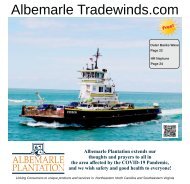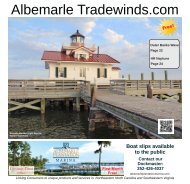Albemarle Tradewinds October 2018 Web Final
October 2018 Edition of the Albemarle Tradewinds Magazine
October 2018 Edition of the Albemarle Tradewinds Magazine
You also want an ePaper? Increase the reach of your titles
YUMPU automatically turns print PDFs into web optimized ePapers that Google loves.
HRNeptune.com<br />
<br />
<br />
<br />
<br />
Mud Flats to Mission Ready – NAS Oceana by Amy Waters Yarsinske<br />
In the 1880s, a whistle stop named Tunis was the only oasis<br />
of civilization on the Norfolk Southern Railway spur between<br />
the city of Norfolk and the popular amusements and resort<br />
atmosphere of the Virginia Beach oceanfront. Everything<br />
in-between was sprawling farmland that divided Princess<br />
Anne County like a patchwork quilt. Farmhouses, dependencies,<br />
country stores and a couple of schoolhouses and other<br />
public buildings dotted the landscape. Near Tunis – the next<br />
to last rail stop to the oceanfront – a small community had<br />
sprung, growth that prompted residents to give it a name<br />
more fitting to the train’s ultimate destination along Virginia’s<br />
golden shore. The hamlet of Tunis was rebranded Oceana<br />
in 1891.<br />
More than four decades later, in 1938, with the threat of<br />
war on America’s doorstep and the United States Navy<br />
limited to one air station and two grass auxiliary fields for<br />
aviation practice in the Norfolk, Virginia operating area, Rear<br />
Admiral Patrick Neison Lynch Bellinger, then commander in<br />
chief of Naval Air Force Atlantic, received orders to locate<br />
four additional airfields in proximity of Naval Air Station<br />
Norfolk. As retired captain Dexter C. Rumsey II later put it,<br />
Bellinger’s marching orders came down “because they had<br />
so damn many pilots to train so fast.” Two decades after the<br />
war, Rumsey commanded Naval Air Station Oceana.<br />
Between the village of Oceana and the Princess Anne<br />
County courthouse lay five thousand acres of farmland from<br />
which the navy would carve out an air station. The navy’s<br />
choice of this vast tract was purposeful. With low population<br />
density and plenty of elbowroom, the tract made the perfect<br />
location for a military airfield. From auxiliary airfield to master<br />
jet base, Oceana would become a significant example<br />
Amy Waters Yarsinske is the author of several best-selling,<br />
award-winning nonfiction books, most recently An American<br />
in the Basement: the Betrayal of Captain Scott Speicher and the<br />
Cover-up of His Death, and while it has led to major media interviews<br />
and speaking engagements across the country, it importantly continues<br />
the national conversation of POW/MIA accountability. The book<br />
won the Next Generation Indie Book Award for General Non-fiction<br />
in 2014. Amy’s new books include an historical series based on her<br />
favorite Virginia, North Carolina and Washington, D.C. locales and<br />
historic sites, the first of which, Norfolk Through Time was published<br />
on the spring list this year; a whistleblower’s story set against the<br />
backdrop of rampant scientific misconduct; the biography of one of<br />
America’s greatest twentieth-century aviators; the story of a murder<br />
in Tehran that would change the trajectory of history, two more<br />
narratives that will make it clear that America still has a crisis of accountability<br />
for its missing service members, and the story of Norfolk<br />
Botanical Garden, a Virginia Historic Landmark that is also listed on<br />
the National Register of Historic Places.<br />
Yarsinske lives in Norfolk, Virginia, with her husband and three<br />
children.<br />
Want to know more? Follow Amy’s blog ‘The Author’s Desk’<br />
amywatersyarsinske.com/blog<br />
of an air station that had a city grow around it, not the other<br />
way around.<br />
Bellinger’s effort to secure auxiliary airfields had been a<br />
work in progress for nearly three years when the worst that<br />
could have happened did. On December 8, 1941, the United<br />
States Congress declared war on the Empire of Japan in<br />
response to that country’s surprise attack on the American<br />
naval base at Pearl Harbor, Territory of Hawaii, the prior day.<br />
The declaration was drafted an hour after President Franklin<br />
D. Roosevelt delivered his remarkable “Day of Infamy”<br />
speech. Following the United States’ declaration, on December<br />
11, Japan’s allies, Germany and Italy, declared war<br />
on the United States, and the United States reciprocated,<br />
bringing the United States fully into the Second World War.<br />
With a new sense of urgency, naval personnel descended<br />
quickly on the mud flats of auxiliary landing field Oceana,<br />
hastily building a series of nineteen Quonset huts to accommodate<br />
32 officers and 172 enlisted men. At the peak of the<br />
war, the remote and largely inaccessible auxiliary landing<br />
field was commissioned Naval Auxiliary Air Station Oceana<br />
on August 17, 1943. This was just the beginning. In the<br />
decades that followed the Second World War, the air station<br />
and the community around it grew with naval aviation. The<br />
nascent auxiliary air station grew so fast that less than a<br />
decade after the war, the navy built additional runways and<br />
training facilities. The evolution of Oceana postwar sent a<br />
clear message that it could no longer function as a subordinate<br />
to any other air station. The secretary of the navy<br />
redesignated Oceana a naval air station on April 1, 1952, a<br />
move that ultimately laid the foundation for development of<br />
the master jet base.<br />
Garrett Smith<br />
Owner<br />
Bedliners<br />
Accessories<br />
Truck Gear by<br />
Line-X<br />
A once-remote auxiliary air station that sprung from the<br />
mud flats of old Princess Anne County near the whistle stop<br />
of Oceana, from which it gets its name, Naval Air Station<br />
Oceana has advanced in the decades since World War II<br />
to become the navy’s East Coast master jet base and one<br />
of the largest and most advanced air stations in the world.<br />
Through interviews, exhaustive research and rare and<br />
often never-before-seen photographs that are her hallmark,<br />
author and historian Amy Waters Yarsinske tells the story of<br />
vision, courage and commitment that reinforce what Admiral<br />
Michael G. Mullen, then chief of naval operations, said of<br />
Oceana when he testified before the Base Realignment and<br />
Closure (BRAC) commission regional hearings on August<br />
4, 2005, his words just as relevant today as they were then.<br />
“We know how important it is to our training. We know how<br />
important it is to our preparation for warfighting. We know<br />
how important it is to be good neighbors, and we will continue<br />
to be. Our sailors and their families – and I include my<br />
own family on that list – enjoy living in the wonderful communities<br />
of the great state of Virginia,” he continued. “Mr.<br />
Chairman [Anthony Principi], I need now – your navy needs<br />
now – Naval Air Station Oceana.”<br />
VA/NC<br />
252-232-8779<br />
470 Caratoke Hwy<br />
Rt. 168, Moyock, NC<br />
www.linex.com<br />
Shane Gerres<br />
Shop Tech<br />
facebook.com/<strong>Albemarle</strong>TradingPost <strong>Albemarle</strong> <strong>Tradewinds</strong> <strong>October</strong> <strong>2018</strong> 33<br />
TM<br />
Protective Coatings<br />
Industrial<br />
Commercial<br />
Marine<br />
Decks<br />
Mention this ad and receive $25 off on bedliners<br />
Or<br />
10% off on accessories

















